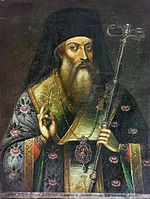How to Pronounce Sophronius of Vratsa
#50
Most Popular
Boost
Mar 11, 1739 Kotel, Sliven Province, Bulgaria Died on 23 Sep 1813 (aged 74)
Bulgarian saint
PiscesSophronius Of Vratsa, Date of Birth, Place of Birth, Family, Facts, Age, Net Worth, Biography and More in FamedBorn.com

Bulgarian saint
Pisces